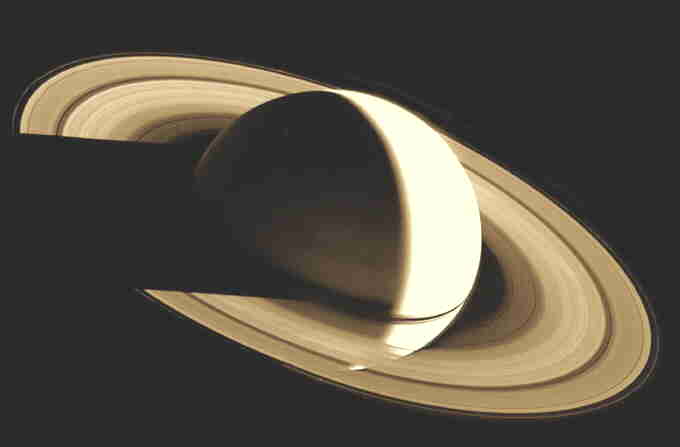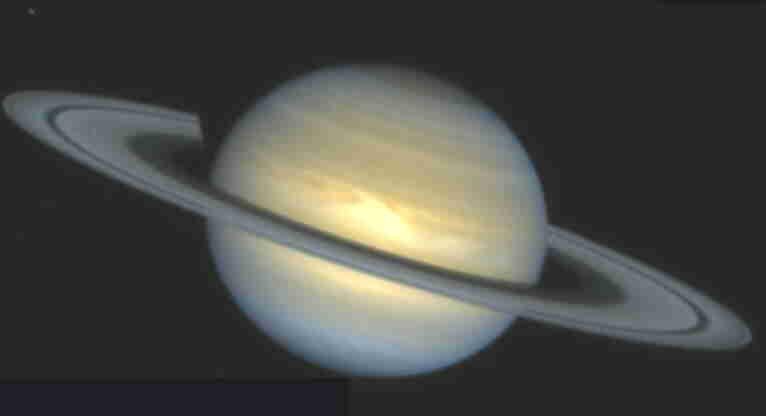




S A T U R N is the sixth planet to orbit the Sun and is the outermost planet that is still conspicuous to the naked-eye. It is one among the four outer gas giants that includes Jupiter, Uranus and Neptune. Yet its true glory, and no doubt great popularity, lies in its magnificent rings that are visible even in small telescopes. Saturn is very like its cousin Jupiter, but lies some 60% further away from the Sun at 9.5 A.U.’s or 1.4 billion kilometres and receives only 1% of the light that falls on the Earth by the Sun. Saturn is the second largest planet in our Solar System whose equatorial girth is 120 000 kilometres across - easily dwarfing the Earth.
Being the planet known to contain the highest percentage of Hydrogen, Saturn is the least dense of all the Sun’s family. The mean density is very much less than the Earth, and if you could place Saturn in a very large large bowl of water it would be buoyant and actually float! Inside Saturn, like Jupiter, we think the planet may have a small rocky core about four or five times the diameter of the Earth.
SATURN DATADiscoverer : Prehistoric Satellites : 30 (2002) 50 (2005) DIAMETER Equatorial : 120 536 km Polar : 108 728 km Oblateness Ratio (i) : 14/13o Period (P) : 29.4563 years Synodic Period : 379.09 days Orbital Velocity : 9.69±0.49kms-1 Eccentricity (e) : 0.0565 Inclination (i) : 2.485o Mass : 5.68x1026 kg. Mean Density : 0.687 g.cm-3 Mean Distance : 433.50±80.98 x108 km Sidereal Rotation : 10h 39m 21s (III) Day Length : 10h 39m 21s Maximum Diameter : 20.1" (arcsec) Minimum Diameter : 14.5" (arcsec) Maximum Magnitude : -0.4 |
We often think Saturn to be a calmer and cooler version of Jupiter. Its clouds do appear less vivid and more yellowish, because the atmosphere is less turbulent and more free flowing. The atmosphere at the visible cloud layer moves continually eastward, averaging about 160 metres per second or 580 kph., peaking in the equatorial regions at about 500 metres per second or 1 800 kph. - ten times more rapid than Jupiter. Saturn’s upper atmosphere has been found composed of 96.3% Hydrogen and 3.3% Helium mixed with compounds like methane, ammonia, water and ammonium hydrosulfide - the latter giving the distinct yellowish colour. Many streaks and faint bands appear frequently to cross Saturnian disk. Ie. The Wide Field Planetary Camera image of Hubble Space Telescope (HST) taken on the 7th March 2003.
Often we can sometimes even see small white spots and storms whose appearance maybe related to solar activity. (See the 1994 HST image of Saturn, above.) These have been recorded at regular intervals over the years. Both the Voyager spacecrafts showed during the early 1980’s detailed close-up images of the many tiny swirls and streaks but little else. With the new Cassini spacecraft to arrive at Saturn at the beginning of 2004 will hopefully show a little more detail with the higher resolution cameras. There is a thin haze, similar to photochemical smog, lies above the planet#8217;s atmosphere that may account for its apparent bland appearance. Flatter than Jupiter disk, Saturn appears as an oval in the ratio of 13:14. This forms due to the planet’s rapid axial rotation of 10 hours 14 minutes.
The appearance of white spots is interesting because they maybe are more prevalent when Saturn is the same place in its orbit. Amateur astronomers saw the outbursts of these spots in 1878, 1903, August 1933 and 1960. This was again occurring in October 1990 and December 1994 seen in the ground based and Hubble images of Saturn. (See below) Most of these events are short lived, often persisting for a month or two.

Fig. 02. HST Image of Saturn in 1994 Showing Equatorial Atmospheric Activity |
The user applying this data for any purpose forgoes any liability against the author. None of the information should be used for regarding either legal or medical purposes. Although the data is accurate as possible some errors might be present. The onus of its use is place solely with the user.
 (NO ADS!)
(NO ADS!)